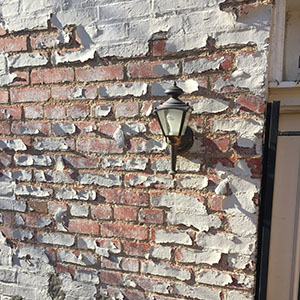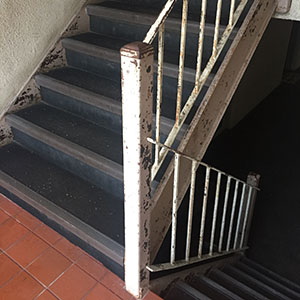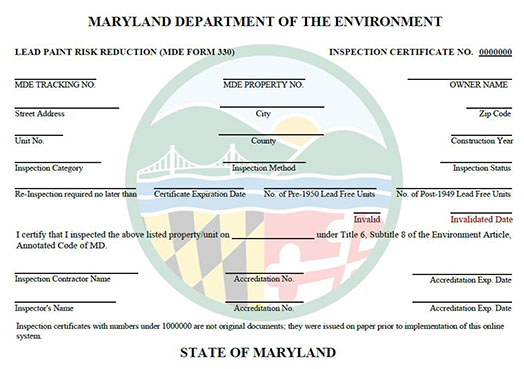Full Risk Reduction Inspection
The MD Lead Law requires pre-1978 rental properties to have a lead certificate. A full risk reduction or lead free inspection is completed to receive a lead certificate. Only visual inspectors or risk assessors can perform a full risk reduction inspection. We recommend the inspection take place before new tenants move in. After the tenants move out, this inspection must be redone before any new tenants move in.
Full Risk Reduction Process
- Visual
During the inspection, the inspector completes a visual. The inspector checks the condition of all painted surfaces. The inspector presumes all paint contains lead. As a result, all paint must be intact. There can be no damaged paint on any surfaces. Meaning no peeling, chipping, or flaking paint. This includes interior and exterior surfaces. It is a requirement because the original paint may be present. The lead paint may exist beneath several layers of paint. Fixing deteriorating paint needs to occur prior to the inspection. For the inspection to continue the visual must pass.
Avoid the following
 Steel lintel chipping paint
Steel lintel chipping paint Peeling paint on deck
Peeling paint on deck Peeling paint on garage door
Peeling paint on garage door Deteriorating paint on fascia board
Deteriorating paint on fascia board Chipping paint on handrail
Chipping paint on handrail Peeling paint on railing
Peeling paint on railing Deteriorating paint on steps
Deteriorating paint on steps Flaking paint on wall
Flaking paint on wall Flaking paint on radiator
Flaking paint on radiator Chipping paint in window well
Chipping paint in window well Peeling paint on door stop
Peeling paint on door stop Flaking paint in common hall
Flaking paint in common hall -
Collection of Dust Wipe Samples

The inspector collects at least one sample from every room. Bedroom, bathroom, kitchen, dining room, family room, powder room, hallway, garage, den, office, laundry room, rec room, enclosed patio, and basement are all considered rooms. All rooms accessed by tenants should be accessible to the inspector.
The inspector will take a sample from the floor or window sill. A window well sample is taken only if there is a wood window. Ensure wood windows are easily opened.
New lead dust standards went into effect on July 1, 2020. The standards are lower. Dust wipes samples for floors are to be below 10 µg/ft2. Dust wipe samples for window wells and sills are to be below 100 µg/ft2. To achieve this, clean floors, window sills, and window wells before the inspection. Use a HEPA vacuum to clean all dust and debris. Follow with wet wiping on non-carpeted surfaces. Use plenty of clean rinse water.
-
Lab Analysis

-
Lead Certificate
After passing the inspection, the owner will receive a lead certificate. The certificate is emailed and mailed. The inspector will send MDE a copy too. You will receive two copies of the certificate. Keep one for your records and provide a copy to your tenants. This certificate is required for a rental license.

Educational Materials
Provide your tenants with a copy of the certificate. Send your tenants EPA’s pamphlet Protect Your Family from Lead in Your Home. Give them MDE’s pamphlet, Notice of Tenant’ Rights. Send documentation every two years if your tenants remain the same.
MDE Tracking Number
A tracking number is required for a lead certificate. You can get this tracking number by calling Maryland Department of the Environment at 410-537-4199.
What to do if you fail the inspection?
If you fail the visual, fix any damaged paint. If you fail the dust wipe sampling, reclean the areas that failed. Use a HEPA vacuum to clean all dust and debris. Follow with wet wiping on non-carpeted surfaces. Use plenty of clean rinse water.
At times, bare concrete floors are hard to pass. If cleaning did not work, painting unfinished concrete floors and applying a sealant usually works. If the paint on the concrete floor starts to deteriorate in the future fix it prior to the next inspection.
Reschedule the inspection to have the inspector retest areas that failed. You have 30 days to pass the inspection.


